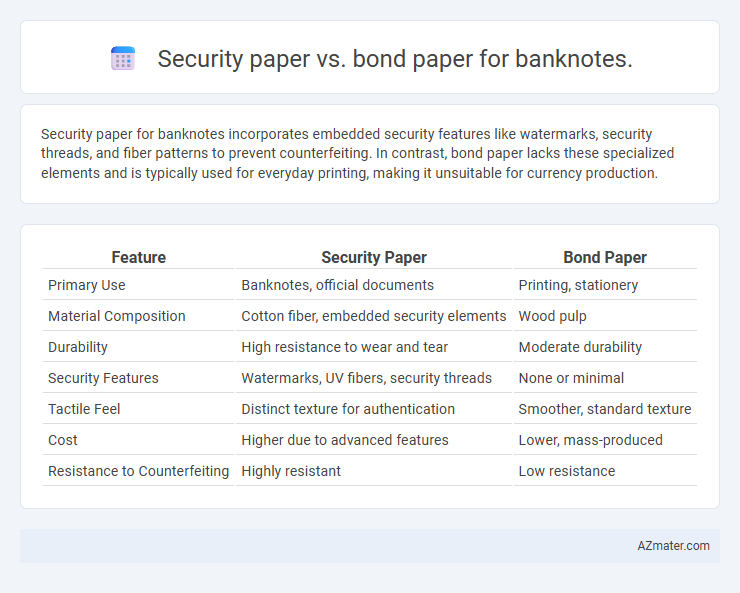Security paper for banknotes incorporates embedded security features like watermarks, security threads, and fiber patterns to prevent counterfeiting. In contrast, bond paper lacks these specialized elements and is typically used for everyday printing, making it unsuitable for currency production.
Table of Comparison
| Feature | Security Paper | Bond Paper |
|---|---|---|
| Primary Use | Banknotes, official documents | Printing, stationery |
| Material Composition | Cotton fiber, embedded security elements | Wood pulp |
| Durability | High resistance to wear and tear | Moderate durability |
| Security Features | Watermarks, UV fibers, security threads | None or minimal |
| Tactile Feel | Distinct texture for authentication | Smoother, standard texture |
| Cost | Higher due to advanced features | Lower, mass-produced |
| Resistance to Counterfeiting | Highly resistant | Low resistance |
Introduction to Banknote Substrate Materials
Security paper and bond paper serve distinct roles in banknote production, with security paper being specifically engineered to prevent counterfeiting through embedded features like watermarks, security fibers, and microprinting. Bond paper, typically used for general document printing, lacks these specialized substrates and security elements crucial for currency authentication. The choice of banknote substrate materials directly impacts durability, security, and the overall effectiveness of anti-counterfeit measures in currency circulation.
Defining Security Paper and Bond Paper
Security paper is a specialized material embedded with features like watermarks, security threads, and chemical sensitizers designed to prevent counterfeiting and unauthorized duplications, primarily used in banknotes and official documents. Bond paper, typically made from cotton fiber or a blend of cotton and wood pulp, is a durable and high-quality writing paper commonly used for letterheads, stationery, and printing but lacks the anti-counterfeiting properties of security paper. The distinct difference lies in security paper's incorporation of covert and overt security elements, making it essential for currency authentication, whereas bond paper serves general high-grade printing without protective features.
Key Physical Properties Comparison
Security paper and bond paper differ significantly in physical properties essential for banknote production. Security paper incorporates embedded fibers, watermarks, and security threads to prevent counterfeiting, while bond paper lacks these anti-fraud features. Additionally, security paper often uses cotton or linen fibers for enhanced durability and crispness, contrasting with bond paper's typical wood pulp composition that offers less resistance to wear and tampering.
Security Features Integration
Security paper used for banknotes incorporates advanced security features such as embedded watermarks, security threads, microprinting, and UV-reactive inks, making counterfeiting extremely difficult. Bond paper, while durable and commonly used for official documents, lacks the sophisticated embedded features essential for banknote authentication and is more susceptible to forgery. The integration of security elements within security paper ensures enhanced protection against fraudulent reproduction, crucial for maintaining currency integrity.
Durability and Longevity in Circulation
Security paper, embedded with watermarks, security fibers, and chemical additives, offers superior durability compared to standard bond paper, enhancing resistance to wear, tearing, and environmental factors. This robustness ensures banknotes retain physical integrity and security features over extended circulation periods, reducing replacement costs and counterfeiting risks. Bond paper lacks the specialized fiber treatments and protective coatings necessary for sustained banknote longevity, making it unsuitable for high-circulation currency applications.
Cost Considerations for Banknote Production
Security paper significantly increases banknote production costs due to embedded features like watermarks, security threads, and special fibers that deter counterfeiting. Bond paper, being a basic, readily available option, offers lower material expenses but lacks the advanced security elements necessary for currency authenticity. Investing in security paper ensures durability and fraud resistance, which, despite higher upfront costs, reduces long-term financial losses from counterfeit circulation.
Printing Compatibility and Quality
Security paper offers superior printing compatibility and quality for banknotes due to its embedded features such as watermarks, security fibers, and microprinting, which integrate seamlessly with advanced printing technologies like intaglio and offset printing. Bond paper lacks these specialized security elements and generally has lower opacity and durability, making it less suitable for high-security printing processes and susceptible to counterfeiting. The enhanced tactile feel and precision in security paper printing ensure higher resistance to wear and forgery, essential for banknote production.
Anti-Counterfeiting Capabilities
Security paper used in banknotes incorporates advanced anti-counterfeiting features such as watermarks, security threads, microprinting, and fiber inclusions that are embedded during the manufacturing process, making replication extremely difficult. Bond paper, while durable and commonly used for general documents, lacks these specialized security elements, rendering it vulnerable to forgery. The integration of UV-reactive elements and holographic strips in security paper significantly enhances the protection against counterfeit attempts, ensuring banknotes' authenticity and integrity.
Global Banknote Material Preferences
Security paper outperforms bond paper in global banknote production due to its embedded anti-counterfeiting features like watermarks, security threads, and microprinting. Central banks worldwide prefer security paper materials, especially cotton or polymer substrates, for their durability and enhanced security properties. Markets in Asia, Europe, and the Americas increasingly adopt polymer security paper for improved lifespan and resistance to fraud compared to traditional bond paper.
Conclusion: Choosing the Right Paper for Banknotes
Selecting the appropriate paper for banknotes is crucial for balancing durability, security, and cost-effectiveness. Security paper, embedded with watermarks, security threads, and other anti-counterfeiting features, offers enhanced protection compared to standard bond paper, which lacks sophisticated security elements. Therefore, security paper remains the preferred choice for banknotes to ensure authenticity and longevity in circulation.

Infographic: Security paper vs Bond paper for Banknote
 azmater.com
azmater.com